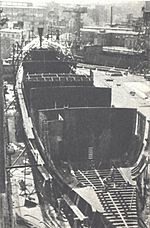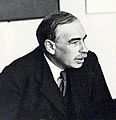Michał Kalecki facts for kids
Quick facts for kids
Michał Kalecki
|
|
|---|---|
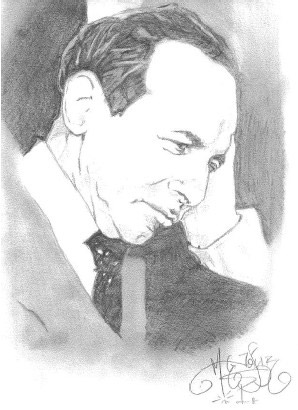 |
|
| Born | 22 June 1899 Łódź, Congress Poland
|
| Died | 18 April 1970 (aged 70) |
| Field | Macroeconomics |
| School or tradition |
Neo-Marxian economics |
| Alma mater | Gdańsk Polytechnic |
| Influences | François Quesnay, Karl Marx, Knut Wicksell, Mikhail Tugan-Baranovsky, Rosa Luxemburg, Joseph Schumpeter |
| Contributions | Business cycle theory, monetary theory, profit equation, theories of mark-up and effective demand |
Michał Kalecki (pronounced MEE-how Kah-LET-skee; 22 June 1899 – 18 April 1970) was a famous Polish economist. He is known as one of the most important economists of the 20th century. Many people say he came up with ideas similar to those of John Maynard Keynes even before Keynes did.
Kalecki worked at top universities like the London School of Economics and University of Cambridge. He also advised governments in countries like Poland, France, and India. He was even a leader at the United Nations Economic Department in New York City.
He was one of the first economists to use mathematical models and data to study how economies work. Kalecki believed that economic choices affect society, not just money. He made big contributions to understanding the business cycle (how economies grow and shrink), economic growth, and how income is shared. He was nominated for the Nobel Prize in Economics in 1970.
Biography
Early life: 1899–1933
Michał Kalecki was born on June 22, 1899, in Łódź, which was then part of the Russian Empire. His hometown was a busy industrial city, and this likely shaped his ideas about the economy.
In 1917, Kalecki started studying civil engineering at the Warsaw University of Technology. He was a very smart student. However, his family faced money problems because his father lost his textile workshop. Kalecki had to work odd jobs to support himself. He even had to pause his studies for military service from 1918 to 1921.
After the military, he went to Gdańsk Polytechnic but had to leave before graduating due to his family's financial situation. He then started working full-time.
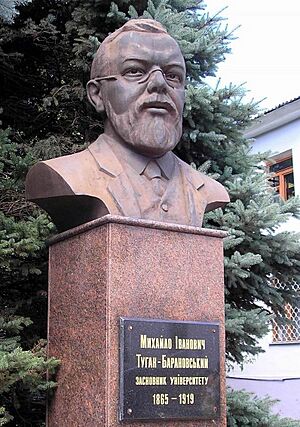
During these years, he started learning about economics on his own. He read books by economists like Mikhail Tugan-Baranovsky and Rosa Luxemburg. Their ideas about how a capitalist system could grow later influenced his own writings.
His first job was collecting information on companies that wanted loans. He also wrote articles for economic magazines. This helped him learn how to gather and analyze economic data, which became very useful in his later work.
In 1929, Kalecki got a job at the Institute of Research on Business Cycles and Prices in Warsaw because he was good with statistics. He worked there for seven years and met Ludwik Landau, who also helped him with statistics. His early writings focused on how different parts of the economy relate to each other. In 1932, he wrote an important article about how cutting wages affects the economy during a downturn.
Kalecki and Keynes: 1933–1939
In 1933, Kalecki wrote an essay called An Attempt at the Theory of the Business Cycle. In this essay, he presented a full theory of how economies go through cycles of growth and decline. His ideas about "effective demand" (the total demand for goods and services in an economy) were very similar to those published three years later by John Maynard Keynes in his famous book, The General Theory of Employment, Interest and Money.
Even though Kalecki's work was important, it was first published in Polish, so not many economists knew about it. He presented his essay at a conference in 1933 and published it in some journals in 1935, but it didn't get much attention at first.
In 1936, Kalecki left his job at the Institute in protest of how his colleagues were treated. He received a special scholarship that allowed him to travel and work abroad. This was lucky because, as a Jewish person, he might not have survived World War II if he had stayed in Poland.
He first went to Sweden, then to England. In England, he learned about Keynes's new book. Kalecki realized that Keynes's book covered many of the same ideas he had been working on. He met Keynes in 1937, but their meeting was not very warm. Even though their ideas were similar, their personalities were very different.
Kalecki never made a big deal about having published his ideas first. As economist Joan Robinson said, "The interesting thing is that two thinkers, from completely different political and intellectual starting points, should come to the same conclusion." Kalecki always gave credit to Keynes for leading the "Keynesian Revolution" because Keynes's position helped these new economic ideas become widely accepted.
In 1939, Kalecki wrote another important book, Essays in the Theory of Economic Fluctuations. This book contained all the main ideas of his economic theories.
Kalecki was excited about the Keynesian Revolution, but he also predicted it wouldn't last forever. In his article Political Aspects of Full Employment, he thought that if everyone had a job (full employment), workers would become stronger, and business leaders might feel their power was shrinking. He believed this would cause businesses to push back against policies that supported full employment, even if those policies led to higher profits.
World War II years: 1939–1945
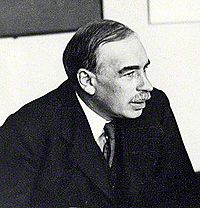
In 1940, Kalecki started working at the Oxford Institute of Statistics (OIS). His main job was to write economic reports for the British government about managing the war economy. He also gave lectures at Oxford University. He developed a plan for rationing goods that was very similar to what the government later put into practice.
During the war, Kalecki wrote several articles about inflation. He argued that the government should use rationing (limiting how much people can buy) instead of trying to control prices and wages directly.
Some of his most important works were written during this time. In 1943, he wrote about new ideas for business cycle theory and a unique theory about how political events can cause business cycles.
In 1945, Kalecki left the OIS. He felt he wasn't appreciated enough and believed he was treated unfairly because he was an immigrant.
After the war: 1945–1955
After the war, Kalecki worked for the International Labour Organization in Montreal for about 15 months. In 1946, he was invited back to Poland to lead the Central Planning Office, but he left after a few months.
By the end of 1946, he became a Deputy Director in the Department of Economic Affairs at the United Nations Secretariat in New York. He stayed there until 1955, mainly working on the World Economic Reports. He resigned from this job because of political pressure during the McCarthy era in the United States. He was accused of being a supporter of communism, which made him very sad, especially since many of his friends were also affected.
In communist Poland: 1955–1968
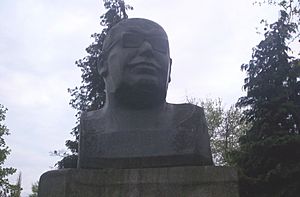
In 1955, Kalecki returned to Poland. He hoped to help with economic reforms there, believing that socialism could avoid the problems of capitalism. He became an economic advisor to the government. In 1957, he was put in charge of a commission to create a long-term economic plan for Poland from 1961 to 1975. This plan was based on his theories of growth for socialist economies. However, his plan was rejected by other officials who thought it was too negative.
Even though his influence in government decreased, Kalecki spent much of his time teaching and doing research. He became a university professor in 1956 at the Warsaw School of Economics and the University of Warsaw. He also became a member of the Polish Academy of Sciences in 1957. In 1959, he started a seminar on economic problems in developing countries with other economists like Oskar R. Lange.
In 1968, Kalecki retired in protest against the government's actions, which included firing many of his colleagues because of their Jewish background.
During this time, he also studied mathematics, especially number theory and probability. This helped him cope with his disappointment about not being able to help his country's economic policy.
Retirement: 1968–1970
Kalecki continued to write research articles. In 1969, his 70th birthday was celebrated in Cambridge, England. He gave a lecture about economic growth in different social systems, and people praised his ideas and his life's work.
Keynes believed that understanding economic laws would make people richer and happier. Kalecki disagreed, thinking that governments might use economic policies for their own benefit, leading to problems. As he got older, Kalecki became more pessimistic about human nature.
Michał Kalecki died on April 18, 1970, at age 70. Even though he was sad about political events, he lived long enough to see his many original contributions to economics recognized. He was known for his strong principles and brilliant mind, and he often resigned from positions in protest against unfairness.
Contributions to economics
Understanding the economy
Kalecki's interest in economics came from his practical work, like engineering and analyzing business data, rather than just from academic study. He didn't even have a formal degree in economics.
He believed that most economic growth models didn't properly consider the important role of the government and how it interacts with private businesses.
In 1943, Kalecki wrote that business leaders often care more about "discipline in the factories" and "political stability" than about profits. He thought that lasting full employment (everyone who wants a job has one) was not good for businesses from their point of view. He believed that some unemployment was a normal part of the capitalist system. Therefore, capitalists often want to limit government involvement in the economy, except for military spending, which they usually support.
Kalecki's economic ideas were based on the idea of the circular flow of income. This means that income is created by spending decisions. He and Keynes argued that in a capitalist economy, how much is produced and how many people have jobs are mainly decided by how much businesses invest. Savings, they said, are determined by investments, not the other way around. Unlike some other economists, Kalecki believed that higher wages could lead to more jobs.
Kalecki was interested in managing demand in the economy. He suggested three ways to boost demand:
- Making it easier for private businesses to invest (which he was skeptical about).
- Redistributing income from profits to wages.
- Public investment, which directly creates jobs and increases demand.
He also studied problems in developing countries. He argued that for these countries to become industrial, they needed to change land ownership and tax wealthy landowners. He doubted that foreign investment would truly help modernize their economies.
Kalecki's ideas about money were also very important. He saw credit as a basic part of how money works in a capitalist economy, not just as banks clearing payments. He believed that monetary policy (how central banks control money supply) was linked to the business cycle itself, depending on business investment rather than just interest rates.
The profit equation
One of Kalecki's most famous ideas is his profit equation. He was influenced by Karl Marx and believed that understanding how much profit is made and how it's shared in a capitalist society was very important.
Kalecki came up with a simple way to explain this. He started with some basic assumptions:
- The economy has two groups: workers (who only earn wages) and capitalists (who only earn profits).
- Workers don't save any money.
- The economy is "closed" (no international trade) and has no government.
With these assumptions, he showed that:

Where:
 is total profits.
is total profits. is total wages.
is total wages. is what capitalists spend on goods and services.
is what capitalists spend on goods and services. is what workers spend on goods and services.
is what workers spend on goods and services. is the total investment made in the economy.
is the total investment made in the economy.
Since workers don't save, their wages equal their spending ( ). So, the equation simplifies to:
). So, the equation simplifies to:

This means that profits are equal to the sum of what capitalists spend and what is invested.
Kalecki then asked: Do capitalists' spending and investment decide profits, or do profits decide their spending and investment? He argued that capitalists decide how much to spend and invest, but they can't just decide to earn more profit. So, their decisions about spending and investment are what determine profits.
This might seem strange at first. If capitalists spend more, you might think they'd have less money left. But for the entire group of capitalists, one capitalist's spending becomes another capitalist's profit. In a way, Kalecki said, "they are masters of their fate."
If you rearrange the equation, you get:

Where  is total savings (profits minus capitalists' spending). This shows that total savings are determined by investment. So, investment creates enough resources to finance itself.
is total savings (profits minus capitalists' spending). This shows that total savings are determined by investment. So, investment creates enough resources to finance itself.
Kalecki then removed the simple assumptions, adding in international trade, government spending, and allowing workers to save. The equation became more complex, but the main idea remained: profits are largely driven by investment, government spending, and exports.
He also suggested that capitalists' spending depends on a fixed amount plus a part of their profits. When you put this into the profit equation, it shows that the total output of an economy is mainly determined by investment. So, changes in investment are key to understanding the ups and downs of a capitalist economy.
Income distribution
Kalecki also looked at how income is shared in an economy. He assumed that businesses operate in markets where they have some power to set prices, like in an oligopoly (where a few large firms control the market). These firms add a "mark-up" to their costs (like raw materials and workers' wages) to cover their fixed costs (like management salaries) and make a profit. The size of this mark-up depends on how much power the firms have in the market.
He summarized this with an equation:

Where:
 is profits.
is profits. is salaries (fixed costs).
is salaries (fixed costs). is the average mark-up.
is the average mark-up. is wages (variable costs).
is wages (variable costs). is the cost of raw materials.
is the cost of raw materials.
This equation helps figure out the share of wages in the national income. Kalecki found that the share of wages in the national income depends on the mark-up and the relationship between raw material costs and wages.
He then studied what happens to the wage share during the business cycle. During a recession (when the economy shrinks), businesses might work together to deal with falling profits, which increases their market power and thus the mark-up. However, the lack of demand also causes raw material prices to fall. During a boom (when the economy grows), raw material prices rise, but stronger unions (because more people are employed) might cause the mark-up to fall. Kalecki concluded that the wage share in national income stays roughly constant throughout the business cycle.
Finally, he showed that the total output of an economy is determined by investment, capitalists' spending, and how income is distributed. This means that changes in investment are the main reason for economic ups and downs.
What drives investment?
Kalecki believed that investment plays a crucial role in a capitalist system. He spent a lot of time trying to understand what makes businesses decide to invest, but he was never fully satisfied with his answers because many factors influence these decisions.
One of his ideas for how investment decisions are made in business cycles was:

Where:
 is the amount of new investment decisions.
is the amount of new investment decisions. is the savings generated by the company.
is the savings generated by the company. represents profits.
represents profits. is the existing amount of fixed capital (like machinery and buildings).
is the existing amount of fixed capital (like machinery and buildings). are constant numbers.
are constant numbers.
This equation shows that investment decisions are positively affected by a company's savings and by how fast profits are changing. They are negatively affected by how much fixed capital already exists.
Kalecki said that this idea alone can explain economic cycles. During good times, companies make more money and profits increase. This leads to more investment. However, as more investments are made, the amount of capital increases, until it becomes less profitable to invest more. This leads to a slowdown, and the cycle continues. Kalecki famously said:
"The tragedy of investment is that it causes crisis because it is useful. Doubtless many people will consider this paradoxical. But it is not the theory which is paradoxical, but its subject – the capitalist economy."
Influence
In the early 1990s, Oxford University Press published 7 volumes of Collected Works of Michal Kalecki, calling him "one of the most distinguished economists of the 20th century." Many of his writings were translated into English for the first time in this collection.
Kalecki's work has inspired many other economists, especially those in the "Post-Keynesian" school of thought, like Joan Robinson and Nicholas Kaldor.
See also
 In Spanish: Michał Kalecki para niños
In Spanish: Michał Kalecki para niños
- Neo-Ricardianism
- Cost-of-production theory of value
- List of Poles
Images for kids



